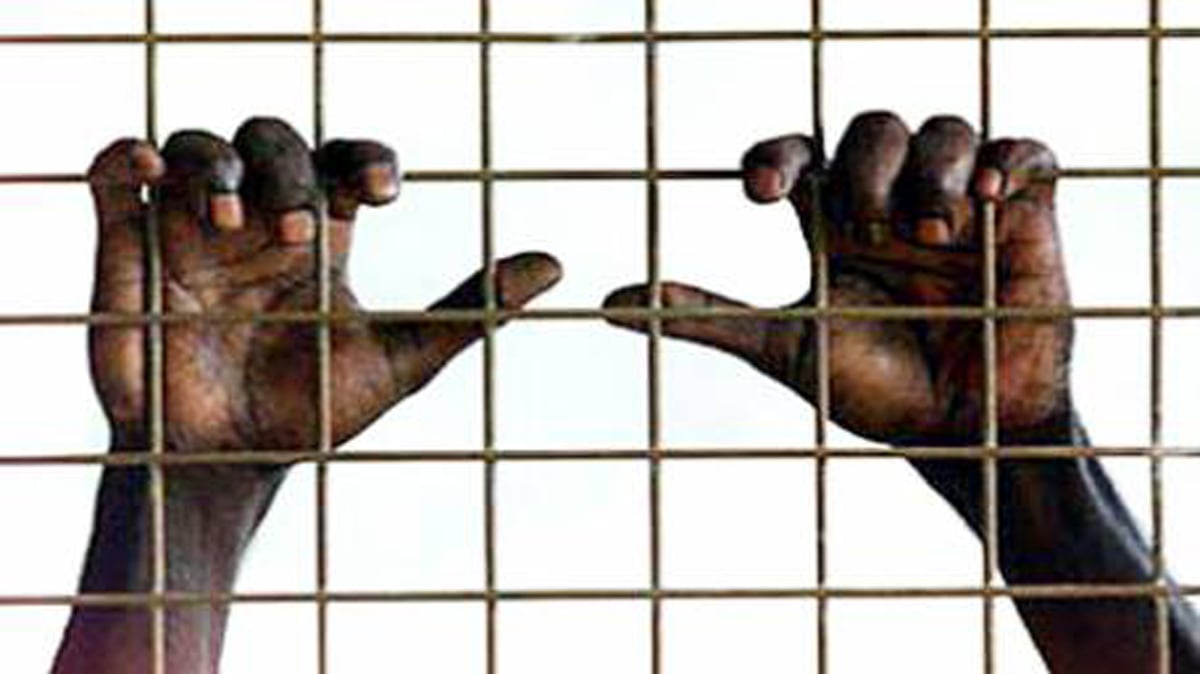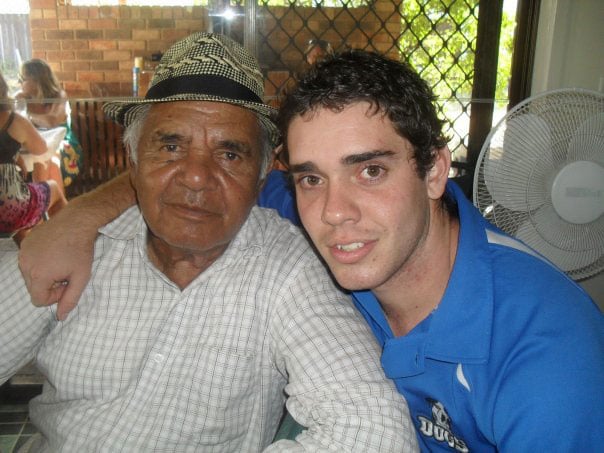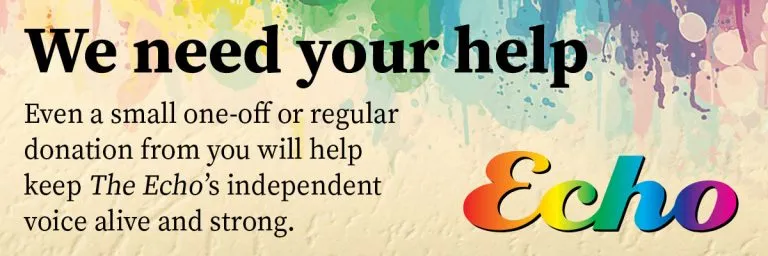
♦ Budgeram means story in Bundjalung language.
The Aboriginal Tent Embassy was established on the lawns opposite Old Parliament House on 26 January 1972. Four First Nations men sat beneath a beach umbrella protesting the government’s attitude towards Indigenous land rights. At the time, the McMahon government was pushing against independent ownership of traditional lands.
The four trailblazers claimed that such a policy would essentially render them aliens within their own lands, emphasising the need for a First Nations embassy. Thus, the ‘Aboriginal Embassy’, as it was known at the time, was born.

From left Michael Anderson, Billie Craigie, Bert Williams and Tony Coorey.
Photo by Noel Hazard, courtesy SEARCH Foundation and State Library of NSW.
From these four men, and the women who stood beside them, a movement grew. From a humble beach umbrella came widespread support and a broader national appreciation for the struggles of First Nations people. This movement and the actions of those four men had a major influence on the establishment of Aboriginal land rights and the fight to end racial discrimination in this country.
As the 50th anniversary of the Aboriginal Tent Embassy draws near, the attention of the nation is again being drawn to the lawns of Old Parliament House. However, this time the actions of the few do not encompass the views and needs of First Nations people more broadly. Such actions do very little for the legacy of the Aboriginal Tent Embassy as its history and prestige are being used as a shield by people with little care for Indigenous advancement.
Conspiracy theories
This is a group who are fueled by conspiracy theories and motivated by the anti-vax movement. The demonstrations are driven by predominantly white agitators who hide behind the veil of First Nations people and Aboriginal rights to push their own agenda. Sadly, Indigenous people have become the faces for this movement, tarnishing 50 years of hard work and progress. Lessening a 234-year struggle for equality and recognition.
Disrespect
These Indigenous faces have disrespected the Ngunnawal people who are the traditional owners of the land in which they protest. Their ‘peaceful’ demonstration has degenerated into almost daily skirmishes with the Australian Federal Police and the shocking vandalism of Old Parliament House itself.
Such actions are not beneficial to First Nations people. They disenfranchise individuals who are starting to show their support for First Nations causes and create frustration for those working to make real progress at a grassroots level.
Sadly, these individuals are demonstrating little more than an overinflated sense of self-importance. They are more interested in preserving their so-called ‘freedoms’ – and to remain unvaccinated while the rest of us do our part to protect and care for our communities. They are more interested in themselves than anything else.
Integrity and hard work the key
In contrast to the demonstrations currently taking place in Canberra, those who have sought change in the past, and have ultimately succeeded, have done so through integrity and hard work. Change has never been achieved through violence. People like Vincent Lingiari saw the importance of peaceful protest. He saw the power of patience and the need for resilience in a struggle that would last for generations. Men like Eddie Koiki Mabo whose fight for justice ultimately outlived himself.
As the dust settles on the scenes we have been seeing in Canberra, it is important to remember that the views expressed by this small, yet loud group of protesters do not represent the views of all First Nations people. We must remember the foundations of the Aboriginal Tent embassy, what it stood for and what it still stands for, despite the belligerent and ill-informed actions of these few.
As 26 January 2022 approaches and emotions remain high, we must remember what those four men and their beach umbrella were trying to achieve. Let us reflect on the progress we have made, and consider the work that is still to be done.

Author
Eli Cook is from the Nyangbal clan of the Bundjalung nation.
His family are descendants of the South Ballina tribe.
As a local school teacher from the Ballina area he has worked closely with the Aboriginal community for the past eight years.
‘I hold a great interest in Aboriginal and Torres Strait Islander advancement and seek to create stronger communities through truth sharing and shared cultural experiences,’ says Eli.
Bugalbee.
More Storylines articles
Invasion Day – time to create unity through recognition and justice
As 26 January approaches our communities are once more gripped by polarised views of the date.
If not now then when?
In 1901, when Australia’s Constitution was originally determined, there was no direct mention of First Nations people. In fact, it was designed to deliberately exclude us.
The moment we can change the course of history
For decades, Aboriginal and Torres Strait Islander people have been campaigning for change to the current political system in Australia. Many incremental changes have led us to this moment in history...
Storylines – The Voice, it’s time
For generations, First Nations people have consistently and persistently pointed to self-determination as being essential in making meaningful difference in the lives of our people.
Storylines – Upcycle the festive season
♦ Budgeram means story in Bundjalung language. Here comes Christmas, the festive season; the year is drawing to a close and we put the icing on the year with the biggest celebration in our collective calendar. For many it’s a problematic time...
Storylines – Boomalli Aboriginal Artists Co-operative
♦ Budgeram means story in Bundjalung language. Thirty-five years ago, ten Aboriginal artists gathered to create an Aboriginal Artists Co-operative in Sydney, the place of first point of contact with the English in 1788, when Captain Cook proclaimed that the land was...
Storylines – Belonging places
Belonging is a feeling of security and support we experience when we experience a sense of acceptance and inclusion in community. Belonging is a sense of being connected to something greater
Storylines – Working with mob
Many are asking ‘who do I talk to?’ if I want to work with mob? Taking the time to yarn, engage and build relationships is key.
Storylines – The Voice of the voiceless
My grandfather would often tell me a story. A story about a community. This community was self-sufficient, self-reliant, and self-determining of their own lives.
Storylines – Returning to old ways of housing
Kinship and Country obligations for mob resulted in bands, or groups of families living together and sharing everyday life, prior to colonisation.














The ATE has nothing to do with vaccination status it is about sovereignty, Justice , land rights n treaty,
It’s authority comes from the Sacred Fire
I think Eli could be a little more focused on the main issue not some manipulated minority who are only a distraction
Change has never been achieved through violence.
Not a lot of thought behind that statement, this continent was changed to being thoroughly Anglo by almost wiping out the oldest continuous human culture on the planet. Violence is never a good idea but the history of human civilisation is the colonial/empire model where power, wealth and influence come from superior military might.
If we’re to have a sustainable future that has to change, a change that violence certainly won’t achieve.
Wonderful photo of those 4 brave men. Thanks for the history lesson!
I think that article was a pretty fair assessment of the current activist movement.
Bravo !
I was in Canberra in 1973 and wasn’t much to see, except one small vacant tent on the old Parliament House lawns.
To-day we have $4M arson and unconcealed venom towards a Community that generally supports their aspirations.
It seems to me they have lost their way somewhere along the road.